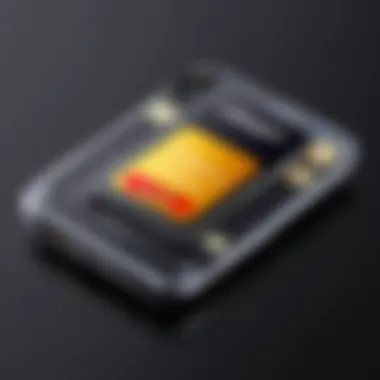Understanding SIM Card Functionality in Galaxy Z Flip 3


Intro
In understanding the SIM card utilization in the Galaxy Z Flip 3, one must first reflect on the role of the SIM card in modern smartphones. This small chip holds significant importance. It facilitates communication by connecting the user to their carrier's network. The unfolding technology within the smartphone industry demands that users are knowledgeable about the components that enhance their user experience. The Galaxy Z Flip 3 stands out not only for its innovative foldable design but also for its unique SIM card requirements and capabilities.
This article will delve into the key aspects of SIM cards regarding the Galaxy Z Flip 3, including the types of SIM cards compatible with the phone, the process of installation, and how to troubleshoot common issues. By comprehending these elements, both new users and tech aficionados can maximize their engagement with this groundbreaking device.
Key Features
When evaluating the Galaxy Z Flip 3, one might focus mainly on its design and performance characteristics. However, the capabilities associated with its SIM card functionality are integral to its overall usability.
Design and Build Quality
The Galaxy Z Flip 3 presents a robust exterior with a folding mechanism. The sleek design accommodates modern aesthetics while ensuring durability. The SIM card tray is strategically located, allowing for ease of access without compromising the device's integrity. The design considers user experience; the placement allows users to quickly change or insert SIM cards when necessary without hassle.
Display and Performance
The Infinity Flex Display of the Galaxy Z Flip 3 furnishes a captivating user experience. A high refresh rate enhances performance, making tasks feel fluid. However, the performance cannot be fully appreciated without a correctly implemented SIM card. Users benefit from high-speed connectivity thanks to the 5G capabilities, which depend on understanding the SIM card's specifications and correct configuration. The fusion of design and technology ultimately enhances the overall performance of applications and services.
Product Specifications
Examining the product specifications highlights the relevance of the SIM card within the Galaxy Z Flip 3 ecosystem. The understanding of these specifications empowers users to make informed decisions about their usage.
Technical Specifications
The Galaxy Z Flip 3 is equipped with modern hardware. It supports dual SIM capability, which enhances flexibility for users who may wish to manage personal and work lines effectively. Furthermore, it is compatible with eSIM technology, allowing for utilization of virtual SIM cards. This flexibility caters to a diverse range of users, allowing for easier travel and service management.
Compatibility and Connectivity
Compatibility is vital. Users must ensure that their chosen SIM card aligns with the Galaxy Z Flip 3's requirements to ensure positive connectivity. Both physical nano SIM cards and eSIM options offer seamless integration with this device. The variety in SIM card options emphasizes the necessity for users to understand their choices, since not all carriers support eSIM technology. As the world adopts 5G technology, it becomes increasingly essential that users select SIM cards that facilitate optimal performance and connectivity.
"A thorough understanding of SIM card types and installation methods is pivotal for enhancing your Galaxy Z Flip 3 experience."
By synthesizing the information regarding the SIM card functionalities, users can elevate their interaction with the Galaxy Z Flip 3, ensuring that they harness its full potential.
Intro to Galaxy Z Flip
The topic of Galaxy Z Flip 3 is vital to understanding the SIM card functionalities and features in this innovative smartphone. Released in 2021, the Galaxy Z Flip 3 showcases Samsung's commitment to folding technology, which has transformed how users interact with their devices. With the added complexities of SIM card options and management, the introduction sets the stage for deeper exploration, benefitting both new users and tech enthusiasts alike.
Understanding the Z Flip 3 is more than just knowing its specs; it involves recognizing how its architecture influences SIM card functionality. Users need to grasp how the device works in conjunction with various SIM technologies, ensuring optimal performance and connectivity.
Moreover, comprehending its capabilities grants users the means to harness the full potential of their mobile experience. This section will help elucidate the significance of the Galaxy Z Flip 3 before diving into the specifics of SIM card utilization.
Overview of the Device
The Galaxy Z Flip 3 presents an elegant and compact design, easily fitting in one hand. It distinguishes itself with a foldable 6.7-inch Dynamic AMOLED display that provides vibrant colors and stunning picture clarity. When closed, a smaller 1.9-inch cover display offers quick notifications and controls without needing to unfold the phone.
This smartphone runs on Android operating system, topped with Samsung’s One UI, which enhances user experience. It is powered by a Snapdragon 888 processor, ensuring fast performance. In addition, the Z Flip 3 comes with features like IPX8 water resistance and Gorilla Glass Victus, showcasing durability typically unheard of in folding devices.
Key Features of the Galaxy Z Flip
The Galaxy Z Flip 3 is equipped with several key features that set it apart. These include:


- Dynamic Display: The full HD + AMOLED display offers exceptional visuals, significantly enhancing the viewing experience.
- Durability: Rated IPX8, the device can withstand submersion in water, a notable feature in smartphones.
- Flex Mode: The folding form factor allows users to utilize a hands-free mode, essential for video calls or media watching.
- Camera Capabilities: Dual rear cameras with high-resolution sensors deliver excellent photography options, complemented by extensive editing features.
The unique combination of these features contributes to a versatile user experience, laying the groundwork for understanding SIM card functionality within the device.
Understanding SIM Cards
Understanding SIM cards is crucial for users of the Galaxy Z Flip 3. The SIM card serves as the gateway for connecting your smartphone to a mobile network. Without it, you cannot make calls, send messages, or access the internet through your carrier. This section outlines the different aspects of SIM cards, including their types, and importance, as well as compatibility with the Galaxy Z Flip 3.
What is a SIM Card?
A SIM card, or Subscriber Identity Module, is a small removable card that contains important data for your mobile device. It links your device to your mobile network provider. The SIM card holds unique identifiers needed for authentication and allows your device to connect to the network. Typically, it stores information such as your phone number, SMS messages, and contacts. SIM cards are essential for activating and maintaining cellular service. Their design and operation are standardized across most devices, including the Galaxy Z Flip 3.
Types of SIM Cards
There are several types of SIM cards that users may encounter. Each type is characterized by its size and technology. This section covers three main types: Nano SIM, eSIM, and Micro SIM.
Nano SIM
The Nano SIM is currently the smallest SIM card format. It measures 12.3 x 8.8 mm. This compact size allows manufacturers to utilize more space for other technologies within the device. In the context of the Galaxy Z Flip 3, the Nano SIM is the primary choice, as the device is designed to accommodate this type. The smaller size also means that it is less prone to damage and can enhance device durability. However, users must ensure that their mobile provider supports this format.
eSIM
The eSIM, or embedded SIM, represents a significant technological advancement. It is not a physical card but rather a chip embedded in the device. This feature allows for remote provisioning of the SIM, which can be advantageous for users who switch carriers frequently. With the eSIM option in the Galaxy Z Flip 3, users can manage multiple subscriptions without needing to physically change SIM cards. However, not all carriers support eSIM technology, which might be a limiting factor for some users.
Micro SIM
The Micro SIM, larger than the Nano SIM but smaller than previous formats, has been widely used in various devices. Its dimensions are 15 x 12 mm. Although it is less common in newer models like the Galaxy Z Flip 3, some users may encounter it in older devices. The Micro SIM offers a compromise for those who have devices that do not support Nano SIMs. However, transitioning from the Micro SIM may require additional adapters or modifications, which can be an inconvenience.
Understanding the different types of SIM cards helps users choose the right one for their needs and ensures compatibility with their devices.
SIM Card Requirements for Galaxy Z Flip
Understanding the SIM card requirements for the Galaxy Z Flip 3 is essential for users looking to maximize their device’s capabilities. Proper knowledge ensures seamless connectivity and leverages the advanced features of this innovative smartphone. Not adhering to these requirements may lead to functionality issues, which can be quite frustrating. Therefore, having a comprehensive grasp on what is needed will make the user experience smoother and more satisfying.
Compatibility of SIM Types
The Galaxy Z Flip 3 supports specific types of SIM cards, primarily the Nano SIM and eSIM format. It is crucial to note that older formats like Micro SIM are not compatible. Here are the essential points regarding SIM type compatibility:
- Nano SIM: This is the most commonly used type for modern smartphones, including the Galaxy Z Flip 3. It is smaller than its predecessors and fits snugly into the SIM tray.
- eSIM: This embedded SIM technology allows users to activate cellular plans without needing a physical SIM card. It is especially useful for those who frequently switch networks or travel internationally.
The capability of using both Nano SIM and eSIM provides flexibility for users. For instance, one can utilize the Nano SIM for a primary line and the eSIM for a secondary line. This dual functionality enhances convenience and connectivity.
Network Provider Compatibility
Not all network providers are created equal, especially regarding SIM card functionalities. The Galaxy Z Flip 3 supports various network bands, but it is essential to verify compatibility with your specific provider. Here are key considerations:
- Carrier Support: Ensure that the carrier supports both Nano SIM and eSIM services for the Galaxy Z Flip 3. Not all carriers have embraced eSIM technology, which may limit options for some users.
- Network Bands: Check that the provider operates within the frequency bands supported by the Galaxy Z Flip 3. This ensures optimal performance. This is particularly relevant if you travel across regions where carriers may operate on different bands.
- Roaming Plans: If you are planning to travel, look into the roaming agreements of your carrier. Some providers offer excellent roaming options while others may incur high charges.
In effect, knowing your SIM card types and ensuring your chosen provider is compatible will lead to a much better user experience with the Galaxy Z Flip 3. Always verify these requirements to avoid unnecessary complications.
Inserting the SIM Card
Inserting the SIM card correctly is crucial for ensuring proper function of the Galaxy Z Flip 3. The SIM card is essentially the gateway to cellular network services and therefore plays a paramount role in the everyday usage of your device. Without a correctly installed SIM card, functionalities such as calling, texting, and accessing mobile data will be either hampered or completely unavailable. Understanding this process not only empowers users but also enhances the efficiency of the smartphone, especially for those who heavily rely on mobile connectivity.


Required Tools
Before beginning the insertion process, it is important to gather the necessary tools. Generally, the essentials include:
- SIM ejector tool: This is often included in the box with the Galaxy Z Flip 3. If you cannot find it, a small paper clip can serve as a substitute.
- Nano SIM card: Ensure you have either a nano SIM card or an eSIM, as these are compatible with the device. A micro SIM will not fit in the SIM slot.
- Clean workspace: A flat, clean surface will help avoid losing small components during this procedure.
Step-by-Step Insertion Process
Inserting the SIM card into the Galaxy Z Flip 3 requires careful execution. Here’s a step-by-step guide:
- Power off your device: Begin by turning off your Galaxy Z Flip 3 to avoid any potential damage or interruptions during the SIM card insertion.
- Locate the SIM tray: On the right side of the device, you will find the SIM card tray. It is essential to identify the correct area to avoid any mistakes.
- Eject the SIM tray: Insert the SIM ejector tool or paper clip into the tiny hole beside the SIM tray. Apply a gentle but firm pressure until the tray pops out slightly.
- Remove the SIM tray: Carefully pull out the tray to expose the slot for the SIM card.
- Insert the SIM card: Place the nano SIM card into the tray, ensuring the metal contacts face down and the cut-off corner aligns as indicated. If using an eSIM, follow specific instructions from your carrier on enabling it.
- Reinsert the tray: Once the SIM card is securely in place, slide the tray back into the phone until it is flush with the device's edge.
- Power on your device: Turn on the Galaxy Z Flip 3 and wait for it to recognize the SIM card. This may take a moment.
Troubleshooting Insertion Issues
There may be occasions where users encounter issues after inserting the SIM card. Here are common situations and their potential solutions:
- SIM Card Not Detected: If the phone does not recognize the SIM card, first ensure it is seated correctly in the tray. Reboot the device to allow system refresh. If it persists, test the SIM card in another device to determine if it is functioning.
- SIM Card Locked: If prompted for a PIN, it means your SIM card is locked. Enter the correct PIN. Be cautious; entering the wrong PIN multiple times can lock the SIM card completely.
- Physical Damage: Inspect both the SIM card and the tray for any signs of damage. A damaged SIM card may require replacement from your carrier.
"A well-installed SIM card can vastly improve your smartphone experience. Proper installation is key to mobile connectivity."
Managing SIM Card Settings
Managing SIM card settings is crucial for optimizing the performance and functionality of the Galaxy Z Flip 3. Understanding how to handle these settings allows users to tailor their connectivity preferences, control data consumption, and troubleshoot common issues effectively. This section will address the important aspects of accessing SIM card settings and configuring cellular data settings, ensuring users have a comprehensive grasp on how to manage their SIM card experience efficiently.
Accessing SIM Card Settings
To access the SIM card settings on the Galaxy Z Flip 3, follow these steps:
- Open the Settings app: This can usually be found on the home screen or in the app drawer.
- Scroll down to "Connections": Tap on this option to view various connection-related settings.
- Select "SIM card manager": Here, users can view information about installed SIM cards and manage their settings.
Inside the SIM card manager, you will find options to enable or disable SIMs, change mobile plans, and configure preferences for each SIM in case of dual-SIM usage.
Configuring Cellular Data Settings
Cellular data settings allow users to manage how their device handles mobile data connections. To configure these settings:
- Within the SIM card manager, select the SIM card you wish to adjust.
- Toggle "Mobile data": This will turn your mobile internet on or off. It’s imperative to only enable mobile data when necessary to prevent unexpected charges.
- Select "Data roaming" option: Enabling this setting allows for connection while roaming outside your service area, although it may incur additional fees.
- Access the "Access Point Names" (APN): This section is essential for setting up your internet connection properly. You may need to enter specific APN details provided by your network provider to access the internet.
Managing these settings is critical as it ensures that users have reliable connectivity without incurring excessive charges or experiencing connectivity issues. This also grants control over which SIM card handles data, especially for those utilizing dual SIM functionality.
"Effective SIM card management can significantly enhance the overall smartphone experience, particularly with a feature-rich device like the Galaxy Z Flip 3."
Thus, understanding how to configure these settings truly empowers users to leverage their device’s full potential. By being proactive and informed, Galaxy Z Flip 3 owners can ensure smooth and efficient mobile communication.
Dual SIM Capabilities
Understanding the dual SIM functionality in the Samsung Galaxy Z Flip 3 is essential for users who wish to optimize their phone usage. The capability to manage two SIM cards simultaneously opens doors to various benefits and caters to diverse communication needs. In an age where connectivity and flexibility are critical, this feature stands out both for personal and professional contexts.
Understanding Dual SIM Functionality
The dual SIM feature in the Galaxy Z Flip 3 enables the device to utilize two SIM cards to access cellular networks. This allows users to maintain two distinct phone numbers on a single device. Each SIM can be managed independently, giving the user choices on which line to use for calls, messages, and data. There are two setups typically possible for dual SIM usage:


- Active/Active: Both SIMs can operate simultaneously, allowing for continuous connectivity. When one SIM is in use, the other remains available for incoming calls or messages.
- Active/Standby: One SIM is active while the other is on standby. Incoming calls on the standby SIM may not come through while the other is in use.
The setup flexibility caters to different use cases, whether it's separating work and personal calls or utilizing different plans to optimize costs.
Benefits of Dual SIM Usage
The advantages of employing dual SIM functionality in the Galaxy Z Flip 3 are numerous. Some key benefits include:
- Separation of Work and Personal Life: Users can manage work communications without mixing them with personal calls, enhancing organization.
- Cost Efficiency: By choosing different carriers, users can benefit from varying rates and coverage areas, potentially saving money.
- Increased Coverage: Dual SIM allows users to stay connected even in areas where one carrier might have a weak signal, ensuring reliability.
- International Usage: Those who travel may find it easier to use a local SIM for data while retaining their primary number for important contacts.
"Dual SIM functionality is not just about convenience; it's about bringing efficiency to daily communication practices."
- Flexibility with Mobile Plans: Users can take advantage of different mobile plans suited for data, calls, or international use depending on needs.
Common SIM Card Issues
Understanding common SIM card issues is vital for users of the Galaxy Z Flip 3. This section addresses potential problems that can disrupt communication and data access. With smartphones, especially modern folding devices like the Galaxy Z Flip 3, users may encounter unique issues that can be frustrating. Knowing how to troubleshoot these common scenarios elevates the user experience and ensures that users can make the most of their device's capabilities.
SIM Card Not Detected
A popular issue that users encounter is the "SIM Card Not Detected" error. This problem prevents the device from recognizing the inserted SIM card, which is critical for network connectivity. There can be several reasons behind this issue, including:
- Physical Issues: Dust or debris in the SIM card slot can hinder contact. Ensure the slot is clean and free of any obstruction.
- Improper Insertion: If the SIM card is not seated correctly, it may not connect with the device's internal components. Remove the card and reinsert it carefully, ensuring it clicks into place.
- Card Damage: Check the SIM card for any physical damage, such as cracks or scratches. A damaged card may require a replacement from your service provider.
- Network Settings: Sometimes, incorrect network settings can lead to detection issues. Resetting network settings can help rectify this.
To resolve this issue, try powering off the device completely before removing the SIM card. After reinserting it, turn the device back on. If still unresolved, check with your carrier to ensure the SIM is active and supported by the Galaxy Z Flip 3.
SIM Card Locked
Another common issue is the "SIM Card Locked" status. This situation often occurs when users insert a SIM card from a different carrier or after a factory reset. The phone requires an unlock code to access the SIM card, which is crucial for connectivity. Users often encounter this for various reasons:
- Carrier Locks: Some carriers place a restriction on their SIM cards, making them usable only with devices purchased from them.
- PIN Code Protection: Users may have set a PIN code for their SIM card. Entering the wrong PIN multiple times can lock the SIM card, requiring a Personal Unblocking Key (PUK) to unlock it.
- Phone Configuration: After a system update or factory reset, the device might need information specific to the carrier.
In cases of SIM card lock, it is essential to obtain the correct unlock code from the carrier. The following steps may guide you:
- Check the PIN settings in the device's SIM management section.
- If a PUK is needed, refer to the carrier’s documentation or customer support to retrieve it.
- Input the PUK correctly; otherwise, the SIM could become permanently disabled.
Always keep your carrier's contact information handy for such situations. This proactive step can save time and trouble if issues arise.
In summary, being aware of these common SIM card issues and understanding their solutions can significantly enhance the experience of using the Galaxy Z Flip 3. Knowing how to troubleshoot can be empowering and can minimize interruptions in communication.
Epilogue
The conclusion of this article underscores the significance of grasping the SIM card usage in the Galaxy Z Flip 3. With the intricacies surrounding SIM technology, a precise understanding aids in leveraging the full potential of this unique smartphone. Recognizing different SIM card types and the requirements essential for compatibility adds to the overall user experience. It also plays a crucial role in issues that may arise during installation and usage, which can impact daily connectivity tasks.
Furthermore, users benefit from knowing how to manage SIM card settings, adjust configurations, and troubleshoot common issues. These skills empower users to solve problems autonomously, leading to enhanced efficiency with their devices. The Galaxy Z Flip 3 is a blend of innovation and technology, and comprehending its SIM card functionalities ensures an optimized experience.
Recap of Key Points
- The Galaxy Z Flip 3 supports various SIM card types, including Nano SIM and eSIM.
- Compatibility with network providers is essential to ensure seamless mobile access.
- Inserting and managing SIM cards requires understanding specific processes.
- The device supports dual SIM functionalities, increasing flexibility for users.
- Awareness of common issues related to SIM card usage helps in prompt resolution.
Future Outlook for SIM Technology
As mobile technology advances, the future of SIM technology looks promising. The adoption of eSIM is gradually increasing, promoting a more streamlined user experience. Users no longer have to worry about physical SIM cards, which could lead to increased security and convenience. Furthermore, as 5G networks expand, SIM technology will adapt, potentially incorporating enhanced features that accommodate higher data speeds and improved connectivity.
In addition, developments in mobile operating systems can offer more integrated solutions for managing SIM configurations. This evolution could lead to simplified user interfaces that require less technical knowledge while maintaining functionality. The central focus will remain on user convenience and connectivity resilience, ensuring that devices like the Galaxy Z Flip 3 continue to thrive in an increasingly technology-driven world.
"Understanding the nuances of SIM technology is essential for optimizing the use of devices like the Galaxy Z Flip 3."
In summary, staying informed about SIM card technology not only enhances the user experience but also prepares one for the ongoing technological shifts shaping the future of mobile communication.

